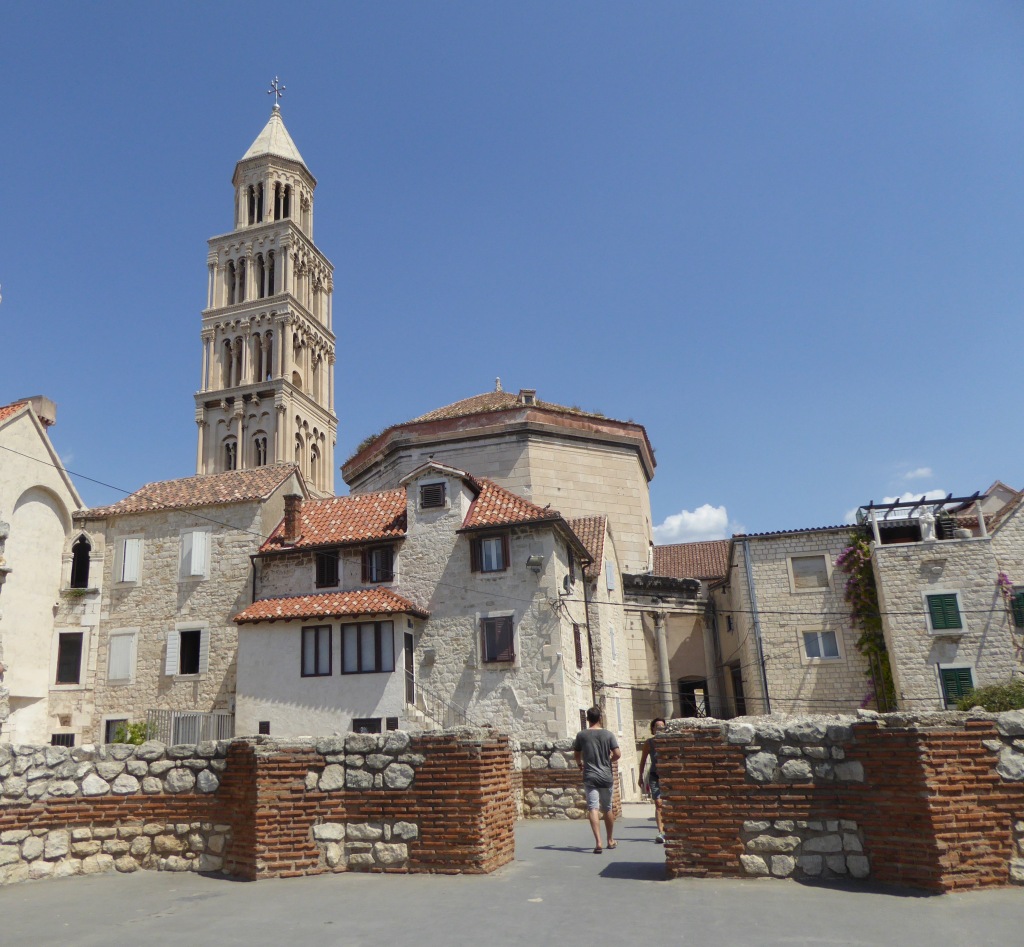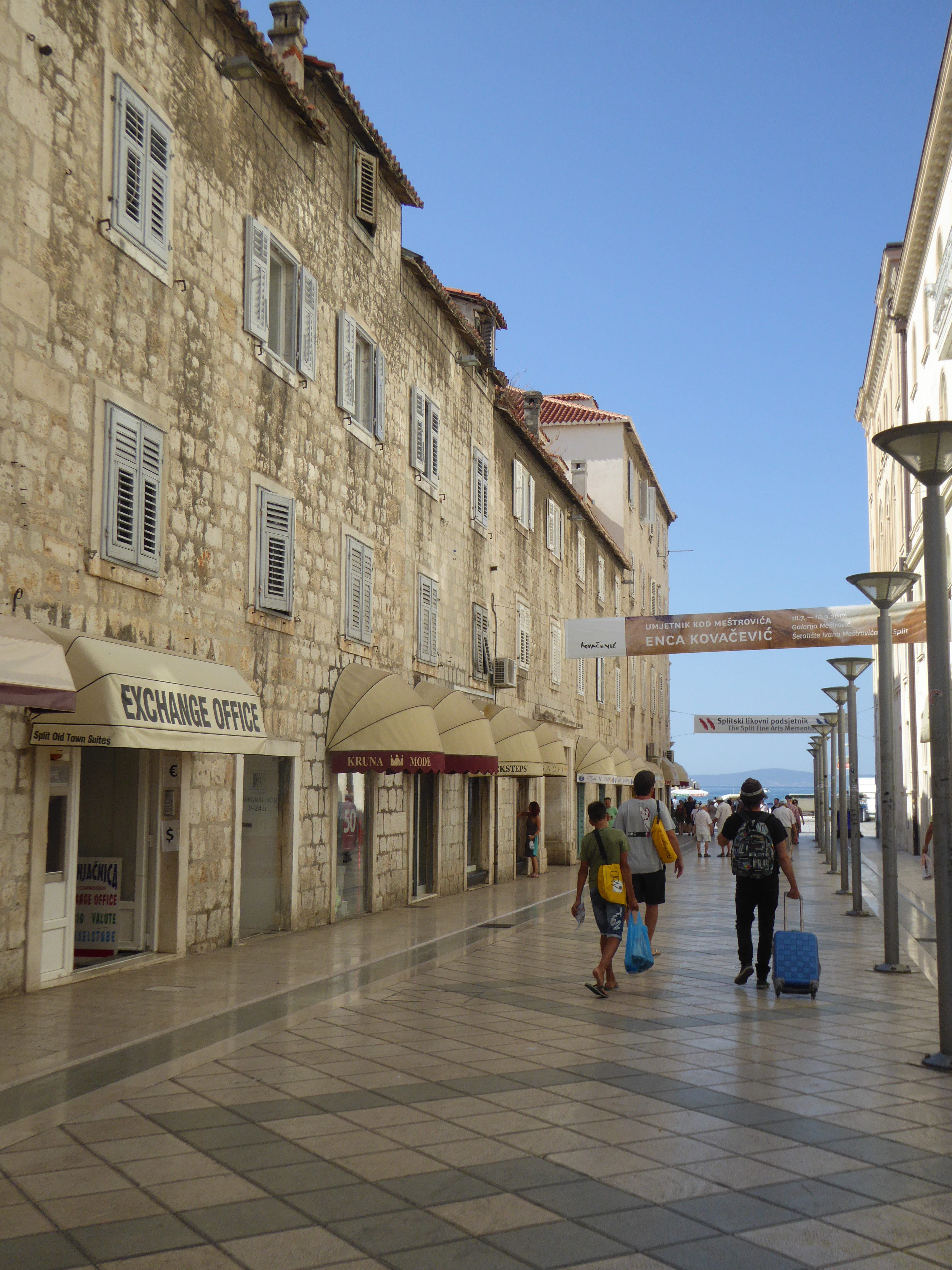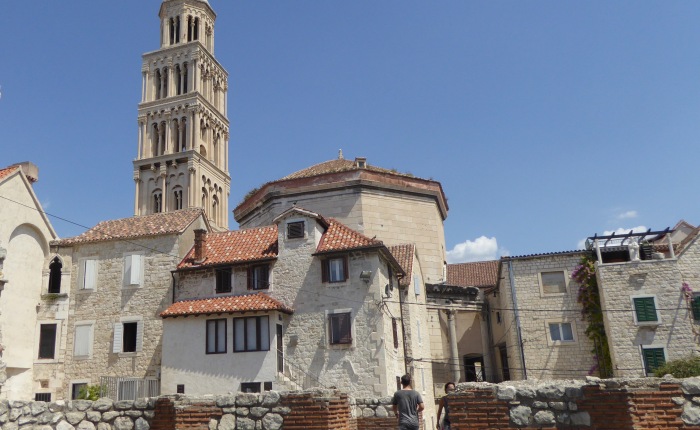Arriving in Split late at night, some hours later than scheduled, with no taxis in sight, I did something I have never done before – that is accept as genuine a person pretending to be a taxi driver, but who was in fact from a chauffeur service. Well, luckily for us, he was from a chauffeur service, so other than a few anxious nail biting moments and costing several times more than a taxi, at least we were delivered to the place on the waterfront where we were to be met by the owner of the apartment where we were staying. To make it worse, I was with KT, who as the wise elder, I had always advised to never, ever accept a ride from a tout, no matter how genuine they seemed, and no matter how tired she was.
We were staying in an apartment in Diocletian’s palace, which had sounded very exclusive, although somewhat difficult to find late at night after a much delayed flight from Rome. Luckily the owner met us at the waterfront to take us through the old town, to the apartment. An apartment in Diocletian’s Palace is not quite as exclusive as it sounds – there are lots of shops, apartments and houses built into the walls of the palace, but it was exotic. Imagine sleeping in Diocletian’s Palace.
After winding our way through what felt like kilometres of narrow, winding passageways, we arrived at the apartment at around midnight. Tired as we were, we toasted our arrival in Split with the wine thoughtfully provided by the owner, looking out to the bell tower of the Cathedral of St Domnius which was beautifully lit up and seemed to shimmer through the darkness.
Diocletian’s Palace was built for the Roman Emperor Diocletian, between 295 and 305CE, as his retirement home. He renounced the imperial crown in 305CE and lived in Split until his death in 316CE. I have some reservations about Diocletian. He was all for torturing and killing those who did not worship Rome’s pagan idols – nothing much has changed over the centuries really. Religious (or pagan in this case) intolerance seems to be a vote winner everywhere.
We only had one morning in Split as our main destination was Hvar, and the late arrival of our flight stole a whole afternoon of our time in Split. We managed to cover a lot of ground that morning, thanks to the owner of the apartment, who offered to give us a guided tour of Diocletian’s palace.
Wandering around, it was difficult to imagine that when it was built, Diocletian had it all to himself – well other than servants and military, but essentially it was his. Bet no one told him that he really should downsize, just as nobody today suggests that the British Royal Family and their like should downsize.
The Cathedral of St Domnius, was originally built as an octagonal mausoleum for Diocletian in AD305, and in which he was interred in 311AD. The Church was consecrated in the 7th century, and the Bell tower was erected in the 12th century. The Temple of Jupiter, which was built by Diocletion between 295AD and 305AD, was converted by Christians into St John’s Baptistry.
The carved double wooden doors of the cathedral are spectacular. They were created by Andrija Buvina in around 1214, and consist of 28 carved panels, depicting the times of Christ. They are carved from walnut and were originally coloured and gold plated. The main altar was created by Morlaiterm, a Venetian in 1766.



The entrance to the Temple of Jupiter was guarded by a black granite Sphinx, one of 12 sphinxes ordered to be bought from Egypt by Diocletian. The faithful Sphinx is still guarding the entrance to the now St John’s Baptistry.
I loved the sculpture of St John the Baptist in the Baptistry. It was created by Ivan Mestrovic in 1954, and stands where Jupiter once stood. Those fingers!



Ivan Mestrovic also created the huge statue of Gregory of Nin, in 1929, situated just outside the Roman Golden Gate (the gate through which Diocletian came and went.) Gregory of Nin is 8.5m tall, has a most expressive face, fingers similar to those of St John. He has huge feet – people rub one of his big toes for good luck. World wide, people seem to rub parts of bronze statues to attract favourable outcomes – I wonder why.



We had time for a quick stroll around Split, and a snack in Pjaca Square, home of numerous cafes and restaurants, and surrounded by lovely buildings, including the Gothic Style Town Hall, former Palaces and a clock tower, which has a 24 hour clockface, with roman numerals. The famous Morpurgo Bookstore, which was founded in 1860, in an old Venetian Palace sadly was not open – and it closed permanently a couple of months after our visit.





Photo credit for clock face: Ante Perkovic/Wikimedia Commons.
Reflecting on Diocletian and his persecution of Christians, I recalled a painting I had seen in Georgia (Caucasus) of St George slaying Diocletian. Given that Diocletian is said to have had St George tortured and beheaded, maybe the artist was depicting good triumphing over evil by replacing the dragon with Diocletian. As a lover of myths and legends, I have previously written about the depiction of St George in art, and included an image of the slaying of Diocletian by St George. If you would like to read it, or at least view the painting, go to Myths and Legends – in search of St George and the Dragon
It was time to catch our ferry to Hvar, so we reluctantly made our way to the wharf, where our ferry was waiting to take us to party island, to meet with family from London, who were already there, partying no doubt. Little did we know.
